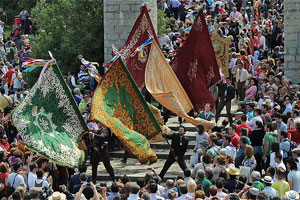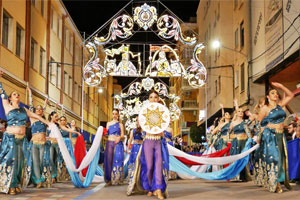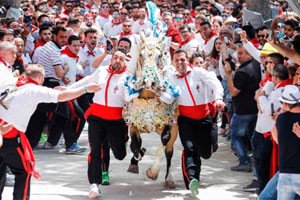Easter Week in Verges

Why should you go and see Easter Week in Verges?
Easter Week in Verges is a unique celebration, and you shouldn't miss it if you're interested in history, culture and religious traditions. It is something totally different, an ancient cultural experience that you should discover.
Here are some reasons why you should not miss Easter Week in Verges:
- It is a centuries-old tradition: Easter Week in Verges has been celebrated for more than 600 years and has become one of the most deeply-rooted traditions in the region.
- The Dansa de la Mort: One of the most eagerly awaited moments of Easter Week in Verges is the Dansa de la Mort (Dance of Death), which takes place on Maundy Thursday night. This dance, which depicts death dancing with people, is a unique and spectacular tradition that cannot be seen anywhere else.
- Impressive processions: During Easter Week in Verges, several processions take place, each with its own meaning and symbolism. The processions are accompanied by musicians and religious figures, creating an impressive atmosphere.
- The procession of the Holy Burial: The procession of the Holy Burial is one of the most emotional moments of Easter Week in Verges. The participants carry an image of Christ and an urn with the image of the Sorrowful Virgin, while there is absolute silence throughout the town.
- A unique cultural experience: Easter Week in Verges is a cultural experience that allows you to get to know the history, traditions and religiosity of the region. You can also enjoy the local gastronomy and visit some of the most emblematic places in Verges.
In short, Easter Week in Verges is a unique celebration not to be missed if you are interested in the culture, history and religious traditions of Catalonia.
Easter Week processions in Verges
The processions take place on the night of Maundy Thursday, and are known for the presence of the "dansaors", the dancers, who perform a macabre dance through the streets of the town. The dancers wear a white tunic and a mask, and carry a rod with bells that they ring during the dance. The dance represents death and resurrection, and is believed to have its origins in medieval times.
The procession begins at the church of Sant Feliu de Verges, where the dancers perform a representation of the Last Supper, with Jesus and the apostles seated at the table. The dancers then begin the dance macabre, which is performed through the streets of the village, with the participation of numerous spectators who come to watch the spectacle.
The procession ends at the church of Sant Joan de Verges, where a liturgical ceremony is held. During Easter Week, in addition to the Maundy Thursday procession, other religious events are held in Verges, such as the Good Friday procession and the blessing of the branches on Palm Sunday.
The Easter Week processions in Verges are one of the highlights of Easter Week in Catalonia and attract numerous visitors every year. The macabre dance of the dancers is considered one of the most unique cultural manifestations of the region, and was declared Intangible Cultural Heritage of Humanity by UNESCO in 2010.
Origin and history of Easter Week in Verges
Easter Week in Verges has a long tradition dating back to the 15th century. The danse macabre performed in the Maundy Thursday procession is believed to have its origins in medieval times, when plague and disease were a constant threat to the population.
The danse macabre was a theatrical performance in the streets of towns and villages, in which death was shown as a character dancing with the living, reminding them of the inevitability of their own death. This dance was performed with masks and costumes, and was accompanied by music and songs.
In Verges, the tradition of the danse macabre merged with the celebration of Holy Week, and the dancers began to represent the passion and death of Christ in their dances. The Maundy Thursday procession, in which the danse macabre is performed, became one of the most important events of Easter Week in Catalonia.
Over the centuries, Easter Week in Verges has suffered ups and downs due to the Spanish Civil War and the banning of processions during the Franco dictatorship. However, the tradition was kept alive thanks to the efforts of the villagers, and in the 1970s the procession was revived and became one of the most important Easter Week events in Catalonia.
Today, Easter Week in Verges attracts thousands of visitors every year who come to see the impressive danse macabre of the dancers and to take part in the religious events held during the week. The Easter Week tradition of Verges is an example of how culture and religion intertwine to create a unique and exciting celebration.
What places to visit in Verges
Monastery of Sant Pere de Rodes: This monastery is located on the top of a hill and offers spectacular views of the Mediterranean Sea and the Pyrenees. It is one of the most important Romanesque monasteries in Catalonia.
- Church of Sant Feliu: The church of Sant Feliu is a Gothic church built in the 15th century. It is a single-nave church with a square bell tower. Inside you can admire a baroque altarpiece.
- Tower of Les Hores: The Tower of Les Hores is a neoclassical tower built in the 19th century. It is one of the most emblematic buildings in Verges and has a clock on its façade.
- Plaça de la Vila: Plaça de la Vila is the main square of Verges. It is a perfect place to relax and enjoy the life of the town. In the square you will find several bars and restaurants.
- Portal del Mar: The Portal del Mar is one of the old entrance gates to the town. It is a Gothic style arch built in the 15th century.
- Fountains: In the village of Verges there are several fountains worth a visit, such as the Font dels Puerros, the Font del Pou and the Font de la Plaça Major.
Near Verges we have places with a great attraction for the visitor
- Figueres: This city is the birthplace of Salvador Dalí, one of the most important artists of the 20th century. In Figueres you can visit the Dalí Museum, which houses a large number of works by the artist.
- Costa Brava beaches: The Costa Brava is famous for its beautiful beaches. Some of the most popular are Aiguablava Beach, Sa Conca Beach and Sant Pol Beach.
- Girona: This city is only 30 minutes drive from Verges and is one of the most beautiful cities in Catalonia. Girona Cathedral, the Jewish Quarter and the Stone Bridge are some of the places not to be missed.
- Aiguamolls de l'Empordà Natural Park: This natural park is a wildlife sanctuary and is one of the most important wetlands in Catalonia. Here you can see a great variety of birds and animals.
- Montgrí Castle: It offers spectacular views of the Empordà plain and the Mediterranean coast.
- Pals: This medieval village is situated on top of a hill and is one of the most beautiful villages in Catalonia. You can stroll through its cobbled streets and admire its stone houses and medieval towers.
Popular gastronomy in Verges
Influenced by Mediterranean cuisine, it has a wide variety of delicious dishes. The following are some of the most popular dishes in the area:
- Escudella i carn d'olla: This is a typical Catalan dish that is prepared during the winter months. It is a meat and vegetable stew served with galets, a type of pasta in the shape of a snail.
- Suquet de peix: This is a fish stew prepared with different varieties of fish, potatoes and a sauce of onion, garlic and tomato. It is served hot and is a very tasty dish.
- Arròs amb llagosta: This is a rice dish with lobster that is very popular in the area. It is prepared with fried onion, garlic, tomato and red pepper and the rice is cooked with fish stock and white wine.
- Fricandó: This is a meat stew made with beef, onion, mushrooms, wine and spices. It is a typical Catalan dish and is usually served with fried potatoes.
- Bunyols de bacallà: These are fritters made with desalted cod, flour, egg, onion and garlic. They are fried in hot oil and served as an appetizer.
- Panellets: These are typical All Saints' Day sweets made with ground almonds, sugar, egg and pine nuts. They are made in different shapes and decorated with pine nuts or grated coconut.
- Local wine: In the Verges area, DO Empordà wines are produced which are highly appreciated for their flavour and aroma. Among the most popular wines are Garnatxa, Carinyena and Cabernet Sauvignon.
Discover the popular gastronomy of Verges and enjoy its delicious Mediterranean cuisine. Enjoy your meal!






